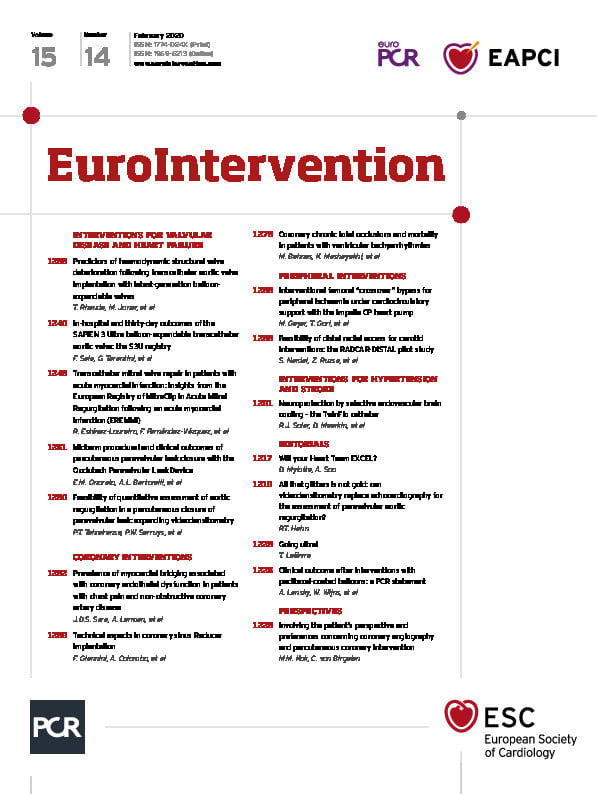
Paris Course on Revascularisation (PCR) statements are intended to represent a practical perspective from the PCR community representing a constituency of ≈60,000 active members on areas of relevant practice based on informed review of evidence and prevailing clinician interpretation. The PCR statement on paclitaxel drug-coated balloon (DCB) use in peripheral interventions was presented at EuroPCR 2019 (Paris, France) to address the ongoing controversy raised by the meta-analysis published in the Journal of the American Heart Association (JAHA). The meta-analysis prompted widespread concern by suggesting that treatment of patients with superficial femoropopliteal artery (SFA) disease using paclitaxel-coated devices (stents or DCBs) is associated with increased death beyond one year compared with uncoated balloon therapy. The risk ratio for all-cause death was 1.08 (95% CI: 0.72-1.61) at one year (28 trials), rising to 1.68 (95% CI: 1.15-2.47) in 12 trials at two years, and 1.93 (95% CI: 1.27-2.93) in the remaining three trials with five years of follow-up. The authors also claimed a 0.4±0.01% increase in the risk of death per paclitaxel mg multiplied by years of observational follow-up1. Paclitaxel DCBs represent the single most important advance in the treatment of patients with symptomatic lower extremity disease, achieving significant reductions in rates of restenosis and need for repeat revascularisations compared to standard balloons2,3,4. Although numerous clinical trials have demonstrated the efficacy of these devices in peripheral arterial disease, none was ever designed or powered to scrutinise differences in all-cause mortality – a prohibitive undertaking that would require ≈40 thousand patients.
The PCR statement cautions that, as for any meta-analysis, the JAHA analysis is subject to major inherent methodological limitations that prevent reliable interpretation of the primary findings. These include the use of study-level rather than patient-level data, limited long-term data and high drop-out rates (28% to 35% in individual trials), with >90% loss of original patient data at four to five years (only three of 28 trials collected long-term follow-up, representing 232 follow-up DCB patients out of the original 2,506 paclitaxel-treated cohort)1, unknown repeated exposure to paclitaxel during reinterventions, lack of adjudication of causes of death, and subsequent corrections to primary source data5. Another challenge is that the reported dose response is ultimately implausible. Beyond concerns about statistical methods, paclitaxel exposure was derived from study-level averages of reference vessel diameter and treated segment length, and dosage was assumed to be constant over time. Paclitaxel delivery varies depending on different methods of drug coating, and animal models have suggested that the pharmacokinetics of solid-state paclitaxel distribution are temporally and systemically complex. Although paclitaxel cytotoxicity makes it useful as an antineoplastic agent for chemotherapy, drug dosage in peripheral arterial disease (PAD) is orders of magnitude lower - making the argument that paclitaxel reaches toxic levels after peripheral angioplasty harder to accept6.
Despite misgivings about the validity of the original meta-analysis and results that are far from conclusive, the PCR statement acknowledges that further evaluation is warranted given the widespread use of paclitaxel in peripheral interventions and the implications of the potential hazard. We recognise that the magnitude and mechanism for such a possible increased mortality risk, including the total paclitaxel exposure by very large devices and repeat use of devices, are very uncertain. The publication did serve as a wake-up call, resulting in swift action on the part of the interventional community, including industry, European regulators and the Food and Drug Administration (FDA), to convene collaborative discussions, new analyses and presentations of patient-level pooled data. Based on its own analysis derived exclusively from US approved devices, the FDA corroborated the existence of a possible “safety signal”, prompting the call for an industry-wide panel meeting. The June 2019 FDA public meeting of the Circulatory System Devices Panel Advisory Committee on paclitaxel-coated devices unanimously agreed on the presence of a possible mortality signal even though its magnitude remains unclear. The panel agreed that a dose response was unlikely considering the assumptions used to derive dose estimates and suggested that future studies record drug dosage and preclinical work to determine a mechanism to link paclitaxel use to long-term death. In final analysis current DCBs will remain on the US market; however, the potential increased risk of death will be included in device labelling. The FDA stated that treatment recommendations should be based on informed consent to help patients weigh the risk-benefit in selecting treatment alternatives considering a possible risk of late mortality against reduced symptomatic reintervention rates and improved quality of life, especially in patients considered high risk for restenosis and reinterventions.
With scepticism remaining regarding the reliability of existing evidence, the PCR statement concludes that there are not enough data to warrant the continued suspension of clinical trials or a change in recommended clinical practices for DCB use. It points to the lack of quality evidence supporting the observed difference in mortality and the wealth of trials demonstrating the safety of DCBs. The statement emphasises that additional evidence from individual sponsor-driven patient-level analyses of clinical trial data7, as well as large-scale claims data8,9, and other meta-analyses10 have failed to replicate the results of the original meta-analysis with respect to an association of paclitaxel exposure with long-term mortality in SFA as well as coronary DCB applications.
PCR acknowledges the vital need for carefully conducted and adjudicated patient-level analyses to compare long-term safety outcomes. In this context, PCR strongly supports resuming, under careful safety oversight, two large prospective randomised trials (BAlloon versus Stenting in severe Ischaemia of the Leg-3 [BASIL-3] and Swedish Drug-elution Trial in Peripheral Arterial Disease [SWEDEPAD]) that were suspended shortly after the JAHA publication. These trials will add to the vital evidence necessary to evaluate the safety of DCBs to inform clinicians better in everyday practice. Pending the availability of more conclusive data, there is currently no strong evidence to justify changing clinical practice. Clinicians should continue to use their best judgement in the use of paclitaxel-based DCBs for individual patient management.
Conflict of interest statement
A. Lansky reports receiving institutional research support from Trireme Medical, Medtronic and Boston Scientific. A. Cremonesi reports institutional research grants and personal honoraria from Medtronic, Boston Scientific, Abbott and Terumo. B. Scheller is co-inventor on patent applications submitted by Charité University Hospital (Berlin, Germany) in 2001/2002 and has received travel support from B. Braun (Melsungen, Germany). S. James reports institutional research grants and honoraria to the institution from Abbott, Boston Scientific, Medtronic and Biotronik. A. Micari is an advisory board member for Medtronic and consultant for Boston Scientific, Bard and Terumo Corp. G. Sarno reports institutional grants from Boston Scientific and Biotronik. A. Baumbach reports institutional research support from Abbott Vascular and consultation and speaker fees from AstraZeneca, Sinomed, MicroPort, Abbott Vascular, Cardinal Health, KSH and Medtronic. W. Wijns reports institutional grants and honoraria from MicroPort and Terumo Corp. The other authors have no conflicts of interest to declare.
Supplementary data
To read the full content of this article, please download the PDF.

